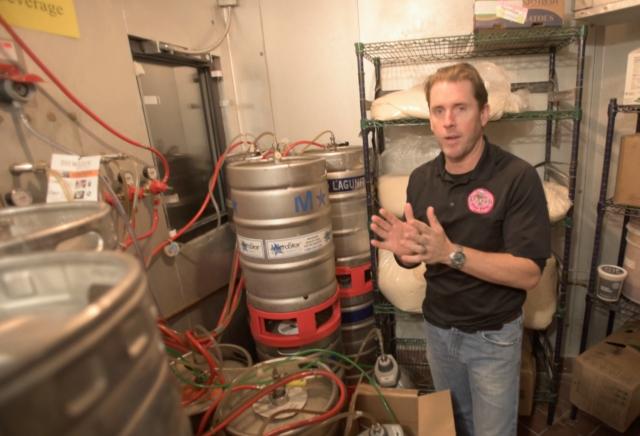reader comments
73
with 59 posters participating
Share this story
Share on Facebook
Share on Twitter
Share on Reddit
Bartender John Olson and owner Dan Lilly of Pinky's Pizza Parlor show us the latest in keg technology from Walnut Creek, Calif. I'm the moderator sporting the Oakland Raiders sweatshirt. RAIDERS!
We at Ars are always on the lookout for new technology. So when I learned (belatedly) that Heineken USA had introduced a
new beer-dispensing technology
called "Brewlock,” I jumped at the chance to review it. After all, only a grizzled reporter with massive experience in the genre could handle a story like the Brewlock. This was a job for a writer who feels just as comfortable drinking alone as he does imbibing with strangers at the local watering hole.
At Ars we're often under deadlines to churn out reviews quickly. But in this case of the Brewlock, I assigned myself no deadline (you can do that when you’re the senior editor). Instead, I spent the better part of six months testing and comparing Heineken's new technology. Because that's what real journalists do. We push the envelope. Whether I pushed too far here and over the years might be better understood by my larger-than-normal bar tabs, breakups, mishaps, and run-ins with law enforcement.
But those are stories for another day.
Let's begin at a local East Bay high school football game where a beer-salesman friend of mine told me that he had started distributing a few beers housed in this new keg technology called Brewlock. I filed that tip away in the vault and told myself I'd act on it after I finished my feature about how the NFL impacts data gathering
beyond the gridiron
.
As par for the course, the tip got buried by other tips, and I forgot the combination to my inner vault. But as luck would have it, while I was “working” one weekday afternoon around Christmas, saddled up to the bar at Pinky's Pizza Parlor in Walnut Creek, California, I noticed that the bartender was now using the Brewlock to dispense Heineken and Newcastle Brown Ale. A lightbulb suddenly went off. I thought to myself: "Now's my chance to dive into this technology."
With that, another paid beer-drinking odyssey had begun.
Meet the Brewlock
Beer has come a long way in the 5,000 years since
ancient Mesopotamians used it to pay their employees
. I won't bore you with all the
different styles and brands
popularized by the microbrew revolution. Suffice it to say, while draught beer is sometimes stored in old-school wooden casks, most beer in the US is kept in modern kegs of stainless steel. Beer is either
pumped out
by hand or via
compressor systems
that usually use
CO2
, but sometimes use
nitrogen
.

Advertisement
The Brewlock, which came to the US in spring 2015, is vastly different. For starters, it's substantially smaller than normal "half-barrel" stainless steel kegs.
Half-barrels
usually contain 15.5 gallons of brew and weigh about 160 pounds filled. By contrast, the Brewlock holds only 5-plus gallons, about 45 pounds of liquid and not much else in terms of other weight. This makes changing out a keg easier, but it has to be done more frequently.
Over the years, Pinky’s owner Dan Lilly has poured me an amount of beer that's unfit to print. He initially liked the smaller Brewlock kegs but, as the months wore on, he and his crew found that constantly changing them was a pain. Brewlocks didn't stack well in his refrigeration unit either, and they use a separate air compressing system than his stainless kegs.
"This seemed great at first, but it kinda wore off over time," Lilly said in a recent interview.
A dead Brewlock keg. It holds a little more than 5 gallons of brew. It's recyclable. Photo: Christopher Schodt
The luscious lineup at Pinky's Pizza Parlor. The Newcastle and Heineken are Brewlock powered. Photo: Christopher Schodt
Brewlock kegs interspersed with regular half-barrel steel kegs at Pinky's Pizza Parlor. Photo: Christopher Schodt
We prepare to taste test and compare these iced Heinekens versus Heineken poured from the Brewlock. Photo: Christopher Schodt
Pinky's bartender John Olson, left, and Ars Technica Senior Editor David Kravets slam a few before we conduct our scientific beer studies. Photo Christopher Schodt
Pinky's owner Dan Lilly takes us inside where few have ever been: the beer and pizza trimmings vault. Photo: Christopher Schodt
A closer look at the Brewlock. You can see the beer line at top and the air-compresser line at right. Photo: Christopher Schodt
John demonstrates the ease of pouring a cold one from the Brewlock. Not a drop was wasted. Another round please. Photo: Christopher Schodt
What Heineken says sets apart the Brewlock from rank-and-file kegs is the rubbery bladder that holds the beer inside a plastic centrifuge. Compressed air is pumped into the recyclable plastic centrifuge, causing the beer-filled bladder to compress—and out comes the beer. Unlike standard kegs, no air touches the beer until it’s poured.
That's it. There's no need for CO2 or nitro calibration which, improperly done, can overly foam, flatten, or simply ruin beer in traditional kegs where air mixes with the beer. What's more, there's little if any beer leftover in the Brewlock. Empty steel kegs usually leave about four to six ounces behind. Over time, that's a lot of wasted brew.
"With the Brewlock, absolutely nothing touches the beer itself," Peter Camps, a commercial marketer for Heineken USA, told Ars in a recent interview. "The end result of this, it will provide the end consumer a much better beer, of higher quality."
“Absolutely nothing” might be an overstatement, as the beer touches the innards of the expandable bladder. And like any beer delivery system, a dirty line from the keg to the tap will ruin any beer, no matter how well it's crafted.
In the Netherlands—home to one of Heineken's breweries and where that beer maintains tremendous popularity—similar bladder systems hold more than 50 gallons, Camps said. "They get their beer with a tanker truck," he said.
Advertisement
Heineken refuses to say what the bladder is made of or how many US-based establishments have glommed onto the Brewlock system.
Holy Grail or gimmick?
Heineken USA only fills the Brewlock with Heineken, Heineken Light, and Newcastle Brown Ale. So if you don't like those beers, it doesn't matter how they’re poured.
Lilly, the Pinky's owner, was kind enough to let me pour as much beer as I needed to test out the Brewlock. He and bartender John Olson also showed me how the kegs are changed in the backroom, and they demonstrated the air-compression system.
(I don’t usually get this type of bar access. It’s been years since I was invited behind the bar at Louie’s, a back-alley tavern in San Francisco’s South of Market neighborhood. That outing didn't end well for me or anyone else involved. Maybe that’s why no other bars that use Brewlock would grant me pouring rights during my Brewlock testing. Or maybe my Oakland Raiders sweatshirt scared them off. Whatever the reason, I couldn’t convince them that I was doing research for a worthy cause.)
In my testing at Pinky’s, beer dispensed with the Brewlock produced a good pour. It wasn't too foamy, and it wasn't flat, either. The only time beer got wasted was when I didn't turn off the tap in time. Whoops.
Because Ars upholds rigorous testing protocols, we tested, side by side, Heineken from the Brewlock and Heineken from the bottle. I tapped (pun intended) several Pinky's patrons to take the plunge, too. Ars' ace freelance photographer, Christopher Schodt, documented it all.
First we discovered was that none of us even like Heineken (more on that later). Next we decided that warm Heineken is even worse than cold Heineken, so bottled Heineken beat Brewlock Heineken in the first round by virtue of it being stored in a bucket of ice. After manipulating the beers until they were of equal temperature, Pinky's bartender Olson poured us a second round. This time, some of our testers chose the Brewlock while others couldn’t taste a difference. What this means is anybody's guess. Because we had several rounds before our testing began, we decided that further testing would not produce reliable results.
After months of testing at Pinky's, Lilly got rid of the Brewlock system. Apparently nobody in the East Bay likes Heineken no matter how it’s kegged. And most bars, Pinky’s included, have limited space for taps and kegs. So when Heineken USA promised him this new technology, Lilly had to lose two other handles to make room. So he gave up Stella Artois and a handle set aside for seasonal beers and customer favorites.
Lilly told me he would never have switched out Stella for steel kegs of Heineken or Newcastle. He only did so because of the promise of Brewlock's new keg technology, he said. All the while, his regular Stella drinkers weren’t happy about the change. When they threatened a Pinky's boycott unless Stella came back, Lilly realized he'd made a mistake.
“This was a gimmick,” Lilly said, “that got Heineken and Newcastle handles here.”
I'll drink to that.









